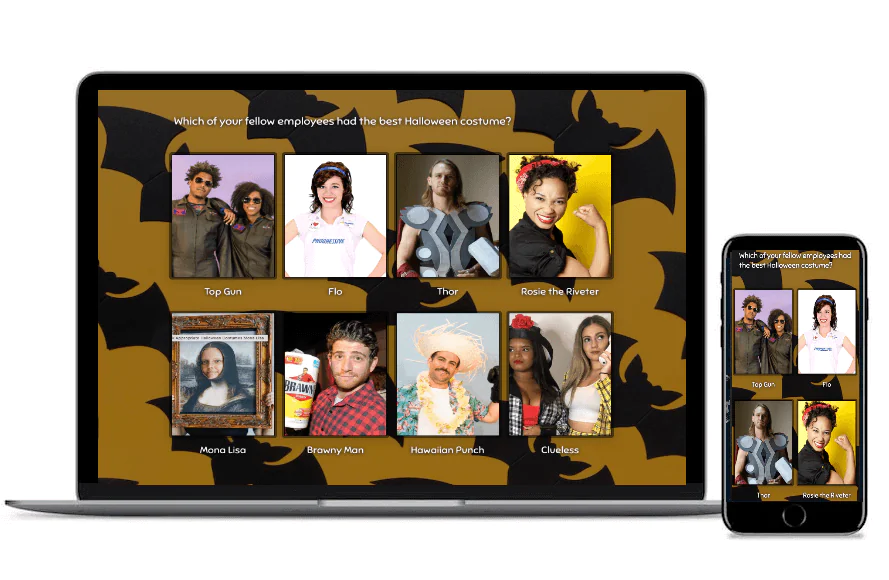A complete trip around the edge of a circle is 360 degrees, which means that if you “do a 360” (as you’ve probably heard when a car spins out in one full circle) you wind up facing the same direction you started. So, what is 360 feedback? In this blog, we’ll take a look at how it works, various feedback tools, 360 feedback sample questions, and more.
Create your 360 degree feedback survey, form, or poll now!
What is a 360 Review?
A 360 degree review, sometimes called a 360 review, got its name because it collects performance feedback from all directions in the company: an employee’s direct manager, a number of their peers, employees that directly report to them, and some functional managers whom the employee frequently interacts with. Each employee also evaluates their own performance.
The purpose of 360 feedback is to give an employee a well-rounded look at how their work is viewed by a cross-section of employees – not just their boss – and allow for self-reflection on their own assessment.
Why is 360 Degree Feedback Important?
A well-thought out 360 degree feedback plan (and solid 360 degree questions) allows everyone in the organization a chance to be heard. Most 360 reviews focus directly on skills and contributions an employee makes, focusing on areas such as accountability, leadership, interpersonal skills, problem-solving abilities, teamwork, and vision (some of these will vary depending on the person’s position).
Each person then has the opportunity to highlight some of the great work they’re seeing from teammates and management, or to voice their concern about problematic employees or management techniques.
On top of this, participants will also perform a self-assessment, which enables them to see how their personal ratings about their work and abilities compare with how others in the company see things. This can lead to greater self-awareness and personal and professional growth.
Top 30 360 Feedback Sample Questions
Earlier we talked about some of the different areas a 360 degree review should entail. Here’s a look at some 360 degree questions you may want to consider asking based on the following skill sets: accountability, leadership, interpersonal skills, problem-solving abilities, teamwork, and vision.
Accountability: Does the Employee…
- Take ownership of their work and strive for excellence?
- Understand their role and how it contributes to team and company success?
- Have the ability to work with little to no supervision?
- Ask for the resources needed to ensure goals are met?
- Acknowledge where he or she can improve?
Efficiency: Does the Employee…
- Accomplish tasks regularly, effectively, and efficiently?
- Work to always be improving the quality or quantity of their work?
- Have some areas for improvement that would help them to work more efficiently?
- Help to improve the efficiency of other employees?
- Understand the short- and long-term impact of their work?
Leadership: Does the Employee…
- Exhibit leadership qualities in the roles they play in the company?
- Provide clear instructions when assigning a project?
- Make your workload manageable?
- Support you and others in their leadership role?
- Regularly make good decisions for the benefit of the team?
Interpersonal Skills: Does the Employee…
- Demonstrate good interpersonal skills and interaction when working with others?
- Help to create a culture that fosters and values collaboration?
- Build meaningful and positive relationships with others?
- Present themselves as a reliable and committed team member?
- Do a good job of managing their own emotions and the emotions of others?
Problem-Solving: Does the Employee…
- Possess the ability to solve problems and arrive at solutions and improvements?
- Seek the opinions of others and use their input when resolving issues?
- React quickly and appropriately to unexpected challenges?
- Provide clear, effective, or imaginative solutions to problems and challenges?
- Does this employee bring together information from relevant sources when making a decision?
Teamwork: Does the Employee…
- Regularly meet deadlines or adhere to schedules to keep the team on track?
- Work collaborate with others to achieve team and company goals?
- Seem interested and engaged when attending team meetings or events?
- Listen to other team members’ concerns on projects, or seem to have a one-man or one-woman mentality?
- “Pass the buck” on projects, resulting in other team members having to pick up the slack?
Vision: Does the Employee…
- Clearly understand the goals and objectives of the company?
- Understand the company culture and work to be a part of it?
- Communicate new ideas or areas for improvement that could benefit the company?
- Demonstrate a defined career path/how far he or she wants to go?
- Seem enthusiastic about their work and the future of the company?
A Sample Performance Review Comment
At the end of the 360 degree review, a supervisor will generally write up a performance review that highlights the comments of everyone involved in the review, from management to colleagues/peers. A sample performance review may look something like this:
In his role of Marketing Coordinator, Patrick generally meets all his goals and deadlines, and often exceeds the expectations of management. He seems excited to take on new tasks and maintains a positive attitude even when things get hectic. He has great attention to detail and is often “the first to arrive and the last to leave!”
Unfortunately, Patrick can struggle with time management and this may stem from his eagerness to take on too many projects at once. He often accepts “on-the-fly” requests from others in the department, and as a result, can get overwhelmed. However, because of his excellent communication skills (which many have complimented him on), we are confident Patrick can learn to say “no” when his plate is simply too full. We also intend to put an end to undocumented requests which should help Patrick.
As an individual, everyone commented on how personable Patrick is and that he is always respectful of others. He keeps a cool head even if things get a little heated in brainstorming sessions, and often brings innovative ideas to the table. It’s my belief that Patrick is a major asset to the team; for now, he needs to work on his time management skills and keep hitting us up with new ideas! In doing so, he should be ready to move up into an Assistant Marketing Manager position within 6-9 months.
How to Create a 360 Feedback Survey
So, ready to get creating a 360 degree Survey? There are a number of steps to take to make sure it’s done correctly and to get everyone’s buy-in.
1. Communicate Your 360 Feedback Plans
If you’ve never done a 360 degree survey, it’s important to communicate the process to everyone involved (this is especially important if your company is used to traditional, non-360 reviews). Make sure everyone understands how feedback will be collected and used.
2. Select Your Raters
Raters are the people who will be providing feedback on various employees. It’s important that each participant has enough raters to make sure the data is comprehensive and relevant (this also helps reduce the impact of outliers on the final results, such as that one person who rarely has anything nice to say).
Raters will be based on a person’s job function and working relationships. However, it should be a mix of peers, supervisors/managers, and direct reports.
3. Choose Your Survey Platform
Today, almost all companies use online 360 feedback tools. While there are many online survey platforms available, SurveyLegend is a very user-friendly 360 degree feedback tool (not to toot our own horn, but we did receive a High Performer Winner in 2021 with 382 reviews on peer review site G2).
Of course, you’re free to look around on G2 or Google for other sites. Just make sure the survey platform you choose offers anonymity or confidentiality (also make sure you know the difference between the two) along with security, as these factors will be key to getting employees to respond.
4. Distribute Your Surveys
After creating your 360 degree questions and loading them into your survey online, it’s time to send them off! Participants will receive an email notification with instructions on how to start the 360 feedback process. Now, it’s up to participants to complete the surveys.
Understand, this may take some time as most employees will be reviewing a substantial number of people. It’s recommended that you establish a deadline, say 2-4 weeks depending on the number of participants and raters.
5. Producing a Report
Once feedback providers have completed all their 360 degree feedback questions, a report will be generated and facilitators will be notified. A supervisor or HR manager will then look at the results, analyzing the 360 degree questions and creating a performance review based upon everyone’s feedback.
6. Hold Feedback Meetings
Now, it’s time for facilitators (a supervisor, an HR manager, or an external participant) to meet confidentially with all participants to review the results. It’s important to identify key areas for improvement, but also be sure to provide praise when a job has been well done.
If necessary, additional training, workshops, or mentoring could be recommended if needed.
7. Reevaluation in 12 Months (or less)
360 degree reviews aren’t a one-and-done. They need to be conducted at least once per year to check in on the progress of employees and see if anything has changed (for better or worse) with employees over time. So, be sure to let staff know that this will be coming around again in about 12 months!
Conclusion
Collecting 360 degree feedback is a great way to get a gauge on your employees (and to determine who needs to make improvements and who deserves a fist-bump). In fact, more than 85% of all Fortune 500 companies use the 360 feedback method for employee review.
“There is one thing we’ve personally seen that profoundly and consistently changes lives,” write consultants Jack Zenger and Joseph Folkman in the Harvard Business Review. “…the 360-degree feedback process.” We couldn’t agree more!
Does your company use the 360 degree feedback process? What kind of 360 degree questions do you ask? We’d love to hear from you!
Create your 360 degree feedback survey, form, or poll now!
Frequently Asked Questions (FAQs)
A 360 degree review collects employee performance feedback from all directions in the company: an employee’s manager, several peer colleagues, direct reports, and sometimes other functional managers who the employee frequently interacts with. Each employee also evaluates their own performance.
The purpose of 360 feedback is to give an employee a well-rounded look at how their work is viewed by a cross-section of employees – not just their boss – and allow for self-reflection on their own assessment so they can make improvements if needed and grow personally and professionally.
Most 360 reviews focus directly on skills and contributions an employee makes, such as their accountability, leadership abilities, interpersonal skills, problem-solving abilities, contribution to the team’s work, and their vision for the future (some of these will vary depending on the person’s position).
Yes! Today more than 85% of Fortune 500 companies use them.




